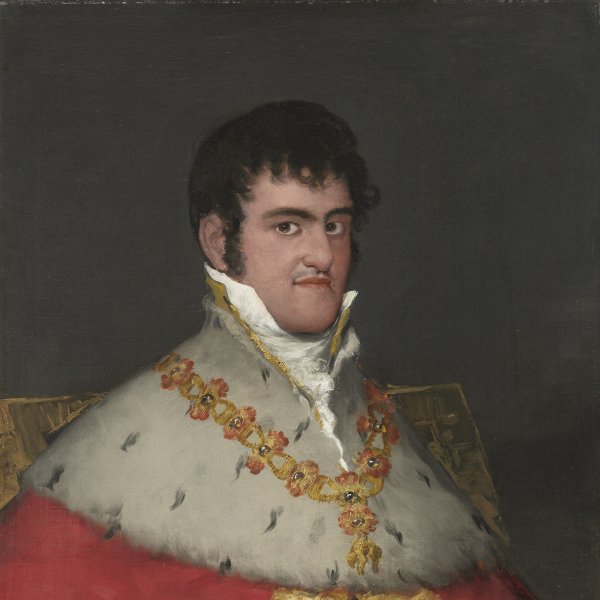Portrait of Asensio Julià
The inscription in the bottom left corner of the painting reads: Goya to his friend Asensi. This dedication and the background of wooden scaffolding and beams, paintbrushes and other tools of the artist’s trade, suggest that the sitter may be the Valencian painter Asensio Julià, who worked with Goya on the frescoes in the hermitage of San Antonio de la Florida (Madrid) at around the time this portrait was painted.
In its skilful arrangement of the figure and loose, confident brushstrokes, this painting may be seen as a forerunner of the Romantic movement.
EA
The lower left edge of the present canvas has the inscription “Goya to his friend Asensi”. Together with Asensi Julià’s known activities as an artist in the circle of Goya, this has led to the hypothesis that the present work is portrait of the Valencian painter Asensio Julià Alvarrachi (1760–1832), who worked with Goya on the frescoes of San Antonio de la Florida in Madrid. The planks and beams of wooden scaffolding that are illuminated on the right behind the figure, the work table on the left, the boards at his feet and the bowls of paint and brushes scattered on the ground have led to the supposition that Goya depicted Julià inside San Antonio de la Florida. This suggestion was first made by Yriarte in 1867 when he wrote a text on this canvas during the time it was in the collection of the Duke and Duchess of Montpensier in the palace of San Telmo in Seville. Yriarte also suggested that the sitter might be an artist, to judge from the implements that accompany him, and that the interior with its scaffolding might be a church on whose decoration he is working. Goya was working in this Madrid church on the frescoes of the dome with The Miracle of Saint Anthony of Padua in 1798, the date that has been ascribed to this canvas.
Asensio Julià Alvarrachi studied at the Real Academia de San Carlos in Valencia where he is documented in 1771 at a very young age, continuing there until 1775. In 1783 he is recorded as applying for a place to continue his studies at the Real Academia di San Fernando in Madrid and would later be appointed associate director of the Escuela Real de la Merced in Madrid where he was responsible for the area known as “ornamentos”. According to Gil Salinas Goya and Julià first made contact in Valencia in 1790 where Goya had moved for reasons of his wife’s health. In the correspondence between Goya and his friend Zapater we find the significant phrase dated 5 August 1789: “Asensio came by today, and is hoping to become Master of Works at the Academy, bringing his letter of recommendation”. It has been emphasised on various occasions that Julià should be understood as a painter and teacher of ornaments in this reference rather than a Master of Works.
Juliet Wilson-Bareau and Manuela Mena Marqués have pointed to the proto-Romantic nature of the present small portrait. Goya has produced a portrait that combines a carefully meditated presentation of his friend Asensi with a sense of the instantaneous through the turn of the figure’s head and the disordered, informal setting. Yriarte considered this painting to be a work of great quality, executed with a loose but exquisitely precise brushstroke.
In the provenance of the canvas as set out in earlier catalogues of this Collection, as well as in the Sotheby’s catalogue of 1971 and the earlier literature, the painting is stated to have been in the socalled Spanish Gallery of Louis-Philippe of France. However, recent research by Wilson-Bareau and Güdrun Mühle-Mauer has modified and corrected the early references to this painting. It would seem that the origins of the reference to the Spanish Gallery are based on a paragraph by Yriarte in his monograph on Goya in which he states the painting to be in that location. However, the canvas is inventoried in 1846 among the possessions of Queen María Cristina in the palace of Vista Alegre in Madrid. The painting could thus have belonged to Julià himself and have been acquired after his death in 1832. It then entered the collection of the Duke and Duchess of Montpensier, Prince Antoine d’Orléans and the Infanta Luisa Fernando, younger daughter of the Queen, and was displayed in the palace of San Telmo in Seville, to where the collection was moved after the sale of the Vista Alegre palace in Madrid. Before it entered the Thyssen-Bornemisza collection the portrait was offered for sale in Paris on three occasions, twice by Durand-Ruel and ten years later by Arthur Sachs. It subsequently appeared on the art market at Sotheby’s in 1971, at which point it was purchased for the Collection.
Mar Borobia









